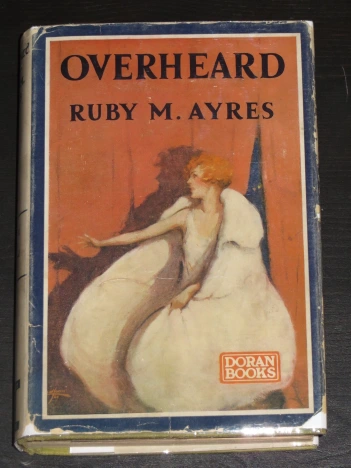 “Sacrificing love, she found it.”
“Sacrificing love, she found it.”
It’s been several years since this blog covered a book by a British romance author. My collection focus narrowed a handful of years ago from all 1920s and 1930s romances to those mostly written by American authors, preferably with American settings. However, I do make the occasional exception!
Ruby Ayres is one of the better known romance authors of the 1920s, and certainly among the most prolific, with a writing career spanning decades. She’s said to be the character inspiration for the P.G. Wodehouse character Rosie M. Banks, something I first heard from a Wodehouse collector and that is mentioned on her Wikipedia page. Her entry in Twentieth Century Romance and Gothic Writers, edited by James Vinson with Ayres’ entry contributed by Rachel Anderson, includes a title list that is three and a half pages long! Hodder and Stoughton published most of her British first editions. George H. Doran Company published most but not all of her pre-1928 American editions before merging with Doubleday, at which point they were published by Doubleday, Doran & Company. Her books were reprinted numerous times. Although this blog features many Grosset & Dunlap first editions, any Grosset & Dunlap copies of Ayres’s books are reprints.
Happily, my copy of Overheard is the George H. Doran American first edition, published in 1926. The dust jacket art is signed, but unfortunately I can’t decipher the artist signature, not even with a magnifying glass in good light. If anyone has a lead on the artist, please let me know! The illustration does resemble the protagonist, Diana Grantham, with her “short red curls” (8), and depicts the moment Diana overhears the conversation that ends her engagement.
The plot summary on the dust jacket begins, “How often the chance remark accidentally overheard changes the course of life.” Only this was no “chance remark.” The conversation Diana overhears in her own home is devastating and brutal. Her fiancé, Rolf, is chatting with his best friend, Bansted. On her family, “[Diana’s father] just bought a couple of ancestors,” and “You can almost smell the varnish on ’em, they’re so new.” Rolf makes it clear he’s marrying Diana for her father’s money to save his family’s estate, and that he thinks very little of her. What’s more, there’s “someone else” in Rolf’s life! Bansted sympathetically asks if there’s any possible way out of the upcoming marriage. “None. I’d give my soul if I could believe there was” (pages 12-15).
What an opening! Wanting to know the immediate fallout of the overheard conversation propelled me through most of the exposition and the first quarter of the book.
Diana ends the engagement. Rolf “had never liked her so well as when she had sent him away” (46). Rolf’s faint disdain for Diana begins to dissipate and he feels ashamed of how he treated Diana as well as Jean, the woman he threw over in pursuit of the Grantham fortune. His father passes away, the beloved family estate is purchased by Diana’s father, and his friend Bansted declares that Diana was quite the catch and he’d now like her for himself. Rolf goes to Jean, who has been ill from the upset of being thrown over. She happily accepts Rolf’s return and he has regrets as soon as he kisses her. He’s thoroughly miserable.
Ayres introduces another character into the mix with Eleanor Colman, married for miserable fifteen years to a spendthrift husband who she had chosen over Bansted all those years ago. Eleanor is a friend of Diana’s and Bansted employs her to keep Diana close and help him in his pursuit. All of them plus Diana’s father spend time in a country home near Jean, whom Diana has sought.
The plot beings to resemble a house of cards:
- Diana fabricates a wealthy family member to leave Jean a small fortune. Once Jean has the money, she’ll be able to recover while marrying Rolf, even though Diana is heartbroken over this.
- Rolf now reciprocates feelings towards Diana, but will marry Jean to keep his word. Everyone agrees that Jean will die if her heart is broken again.
- Diana accepts an engagement to Bansted, despite her indifference towards him.
- Eleanor Colman’s husband leaves her, and she briefly stands a chance once more with Bansted.
The occasionally shrewd Eleanor decides it’s time to topple the first card. She tells Jean that Rolf loves Diana, is marrying Jean out of obligation, and that Diana orchestrated Jean’s newfound wealth. Eleanor instantly regrets having done this, but it is too late. Jean collapses and dies.
Diana breaks off the engagement to Bansted. With Eleanor and Bansted now both free, Bansted… leaves the country, for good. Ayres tries to have it both ways: simultaneously punishing Eleanor for her various misdeeds, but still giving her a happy ending. Eleanor is without her husband or Bansted and falls ill with remorse over Jean. Diana’s father pays a visit and proposes marriage. It’s strongly hinted that she will agree in the near future.
One of the running themes in the novel is said by Eleanor, “the time one wants a thing most is when one has lost it” (202). It recurs among several character arcs but none as much as Rolf’s. After Jean’s passing, he rejects Diana once more. At this point, Diana perhaps senses Rolf’s fickleness, for as soon as he rejects her, she happily tells Eleanor that he will change his mind shortly. And he does. They hurry up and get married, for better or for worse, before anyone can change their minds again.
While I was drawn into Overheard’s exposition, I felt it did lag in the second half. However, just when the book borders on becoming tedious and overlong, Ayres wraps it up. I will now follow that example.
Copies of Ruby Ayres’s works are available for purchase here.


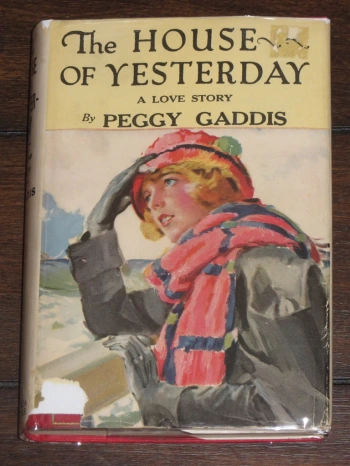 Let’s get it out of the way that I think this book is quite the find. Holy guacamole, a 1929 Peggy Gaddis in dust jacket?! How did I manage that? (Answer: an Abebooks notification paired with swift, decisive action.) I’ll admit that I did a little happy dance when The House of Yesterday joined my collection.
Let’s get it out of the way that I think this book is quite the find. Holy guacamole, a 1929 Peggy Gaddis in dust jacket?! How did I manage that? (Answer: an Abebooks notification paired with swift, decisive action.) I’ll admit that I did a little happy dance when The House of Yesterday joined my collection.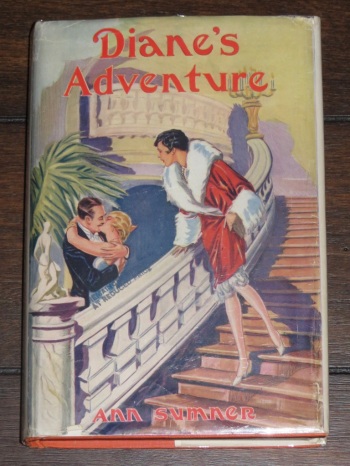 Yikes, this blog is multiple book reviews behind again! Let’s dig into a book I read… more than ten months ago. Here is the story of Diane Du Bois, a woman who ran away from home to Hollywood and achieved instant fame, success, and of course, romance.
Yikes, this blog is multiple book reviews behind again! Let’s dig into a book I read… more than ten months ago. Here is the story of Diane Du Bois, a woman who ran away from home to Hollywood and achieved instant fame, success, and of course, romance.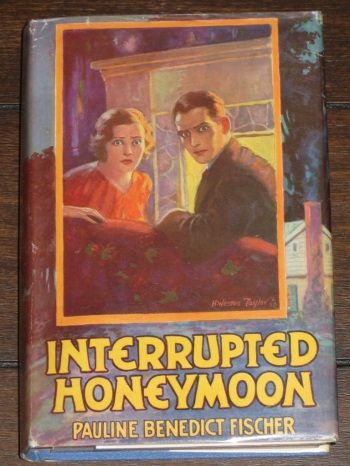 Too often, it feels like few collectible copies of the books I collect are newly arriving on the book market. In early 2022, right when I felt like I was in a book collecting slump,
Too often, it feels like few collectible copies of the books I collect are newly arriving on the book market. In early 2022, right when I felt like I was in a book collecting slump,  Happy 100th Birthday to The Trail of Conflict by Emilie Loring!
Happy 100th Birthday to The Trail of Conflict by Emilie Loring! Copies of Emilie Loring’s works are available for purchase
Copies of Emilie Loring’s works are available for purchase 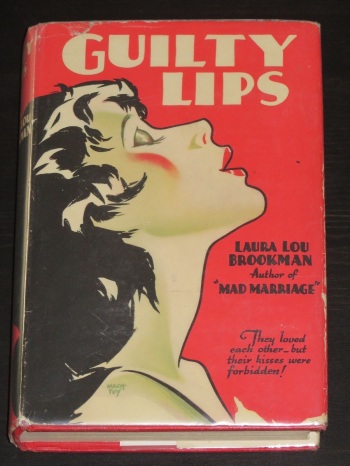 This post has been co-written by Jess and her friend, Doug.
This post has been co-written by Jess and her friend, Doug.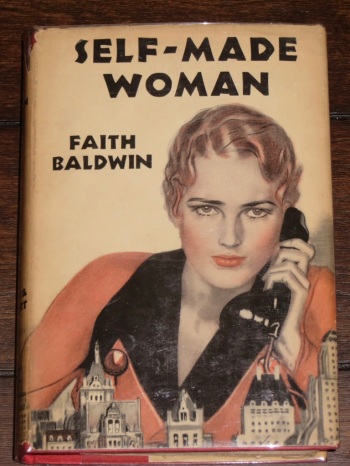 A confession: this blog is now three books behind. It’s not ideal. The pile of read books stacks up, and then I try to review something I read several months and many books ago. Let’s dig into one of these. First up, the rage read!
A confession: this blog is now three books behind. It’s not ideal. The pile of read books stacks up, and then I try to review something I read several months and many books ago. Let’s dig into one of these. First up, the rage read! Copies of Faith Baldwin’s works are available for purchase
Copies of Faith Baldwin’s works are available for purchase 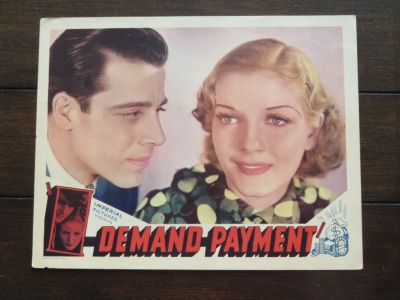 To steal a quip from the title of an IMDB user review, “I demand my time back.”
To steal a quip from the title of an IMDB user review, “I demand my time back.”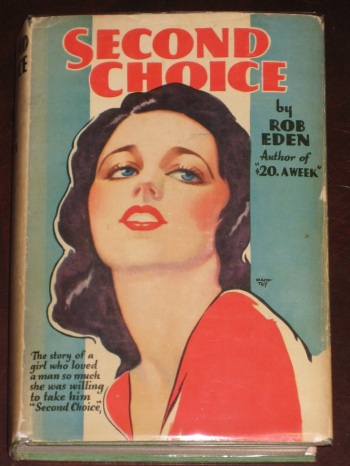 Why didn’t I read this book sooner? Perhaps, when compared with some of the other Rob Eden titles on my bookshelf, this one was always… Second Choice.
Why didn’t I read this book sooner? Perhaps, when compared with some of the other Rob Eden titles on my bookshelf, this one was always… Second Choice. Copies of Rob Eden’s works are available for purchase
Copies of Rob Eden’s works are available for purchase 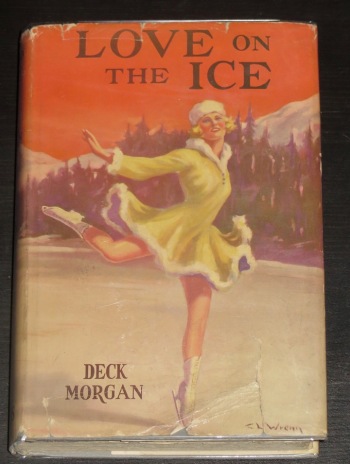 Love on the Ice is what happens when a licensed bobsled pilot writes a romance novel about an up-and-coming figure skater.
Love on the Ice is what happens when a licensed bobsled pilot writes a romance novel about an up-and-coming figure skater.